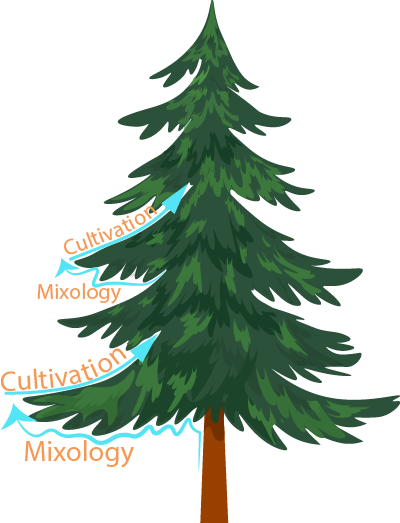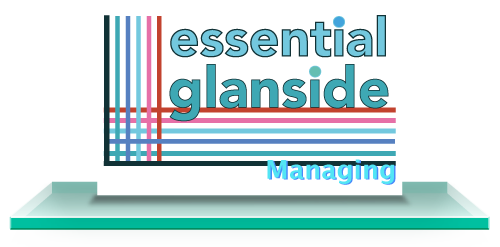 How does Essential Glanside work?
How does Essential Glanside work?
Essential Glanside consists of two components.
The first component is The Creative Programme with which creative ideas are managed and developed.
The Creative Programme is designed to take you from a blank sheet of paper or blank screen to a first outline of a creative work.
The second component is The Creative Framework.
The Creative Framework is the mechinery that combines initial ideas into a developed creative work, starting from the specific (the direction, material, concept or theme that you wish to investigate or dissect) and moving to the general (the creative possibilities that result from the use of creating thinking techniques and processes).
 The First Component
The First Component
 The Creative Programme
The Creative Programme
There are six elements that make up The Creative Programme.
Element 1: The Hoard
Establish a place/process for hoarding ideas that are generated from thinking-for-creativity techniques.
In Glanside creative thinking the quality of creative output is linked to the quantity of creative ideas generated.
Within the creative process there must be a place where ideas generated from Glanside techniques are assembled, allowing you to pick through them and select interesting ideas for further development.
You need to be able to sieve through the ideas you have generated, selecting those ideas that meet your initial criteria or warrant further development given the creative task at hand. The ideas that remain can be hoarded for future use in other sections of your creative project.
Element 2: Build from the Specific Ideas
Creative direction flows from the specific to the general.
Begin with specific ideas: a clear direction, belief, material, concept or theme that you wish to investigate or dissect.
The establishment of these specific ideas - the foundation on which a creative work is developed – falls into the ‘White Hat Thinking’ described in De Bono’s 6 Thinking Hats approach.
The chosen combination of specific ideas is crucial to the creative process. The manner in which you define the problem to be investigated, and the ideas you mix in order to embody that problem, is an essential part of the creative development of your work.
Element 3: Introducing General Ideas to trigger creativity
At the core of creative thinking is a reaction in which different ideas combine and coalesce to form intriguing new material.
Creativity comes from the mix and combination of diverse, different and disparate ideas (termed general ideas), together with the specific ideas you chose as your starting point.
The aim of the use of Creative Thinking Techniques is to generate general ideas that can be used to develop a creative work through a reaction with specific ideas on which you are building.
Element 4 – Fragments
Ideas are often hidden.
Don’t be afraid to gather fragments – that is ‘snippets’ of material that can lead to ideas.
When you revisit these fragments you will suddenly see combinations of fragments that can lead in new creative directions.
It is often the case that the more obscure and unexpected the idea combination, the greater will be the creative appeal of the work.
Revisit the diverse fragments of text, picture or object that you have collected and notice how the mind picks-over and picks-out creative connections and patterns as you work.
Element 5 – ‘Points-of-Departure’
Through the use of Creative Thinking Techniques to combine and further develop specific and general ideas you will create Points-of-Departure.
Points-of-Departure are phrases (or ideas expressed in any other media) which capture an idea that can be developed into a creative text passage or sketch.
Points-of-Departure are like burning pieces of kindling that can be positioned and combined into larger creative flames until the creative fire takes hold.
In using Glanside Creative Thinking Techniques to find new and interesting combinations of ideas, you will find yourself taking a mental ‘glance sideways’ in your thinking. It is this sideways glance that takes you to new points-of-departure.
You are now ready to apply ‘forwards thinking’ again – working forward from these new points-of-departure - to the finished creative work.
Element 6 – Patterns
Look for patterns and logical or creative connections amongst these creative points-of-departure.
By annotating, evolving, broadening, adapting (etc) of points-of-departure and, of course, rejecting them if they are not taking your work in the right direction, a first draft of a creative work is produced.
 The Second Component
The Second Component
 The Creative Framework
The Creative Framework
There are four elements that make up The Creative Framework.
Element 1 – Warp
The weaving of ideas into a woven creative fabric is a good metaphor for Creativity Thinking
The Warp consists of the basic idea threads that hold the whole creative work together.
The best way of producing the Warp is to spread out the idea combinations (i.e. the points-of-departure) that you have produced – and just begin working from these points of departure.
It is important at the warp stage to capture the essential work in a rough format.
Describe in simple sentences (or through outline sketches) the ideas you want to incorporate at that moment in the development of your work.
The Warp sets the strand-and-structure for the work, and holds everything together. It is a difficult stage: but remember that the human is a creative being. This is where the external Glanside creative processes and the internal workings of the mind will come together.
Never lose a good idea. When building the Warp you often find a new creative point-of-departure that you are not able to incorporate at that moment. Place any such idea in your ‘Hoard’ to be revisited later.
The four warp techniques described below can help in the establishment of the warp of any creative work.
Element 2 – Weft
The Weft provides the depth and suppleness of shade, colour and texture to the weave of your creative work.
The purpose of this Glanside website is to offer Creative Thinking Techniques that can help to drive the creative Weft of your work.
Different creative techniques will unearth different creative possibilities.
There are two separate stages in the framing and development of the Weft, with different categories of Creative Techniques used in each stage. In the first stage Mixology Creative Techniques are mostly used. In the second stage the Cultivation Creative Techniques are used.
It is the alternate application of Mixology and Cultivation Techniques that leads to the controlled growth of a creative work, which meets the objectives defined in the opening specific ideas.

Creative Thinking is not an exact science and every creative thinker will discover the approach best suited to their natural character.
Essentially Mixology is the generation of new ideas, and Cultivation is the marshalling and further development of those new ideas.
Whether a technique is best suited to Mixology or Cultivation, however, will often come down to personal preference.
Element 3 – Drafts
The creative Warp and Weft will lead to a developed draft of your creative work – i.e. a woven fabric of creative ideas.
You are very lucky if this developed draft meets all the conscious or unconscious objectives that you have set yourself.
If your work of art is not moving in the right direction, Essential Glanside provides a process and workflow with which you can redraft and recombine different sections of your work, until you obtain creative work that you know to be both precise and true to your objectives.
Element 4 – Playback
The processes in the Creative Substructure and the Creative Framework are not sequential. Mix any and all of the components of the Essential Glanside process as required.
 The Four 'Warp' Techniques
The Four 'Warp' Techniques
Within Glanside there are four creative techniques that can help provide the ‘heavy lifting’ in the establishment of the core structure of the creative work.
These four techniques are particularly useful when establishing the Warp - across which the colourful Weft elements of the work can then be woven.
These four techniques are:
- The Management Technique Material Fusion.
- The Mixology Technique Lens Illumination.
- The Management Technique Scaffolding.
- The Cultivation Technique Facets.
